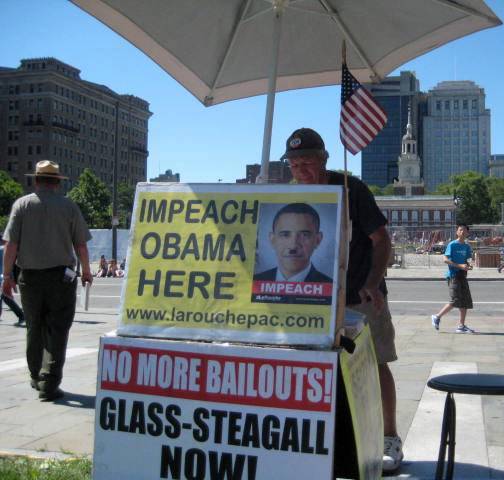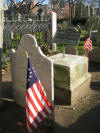Page Title: My Philadelphia
Visitor Tips Philadelphia Sidewalks|
I've made quite a hobby out of going to Philadelphia so I thought I'd start posting things I find around town. |
|
| Scenes from July 4th, 2010. Here's how it's supposed to work in The United States of America. | |
Stand on federal property in the shadow of where they created The Constitution. Protest against The President and the park ranger leaves you alone |
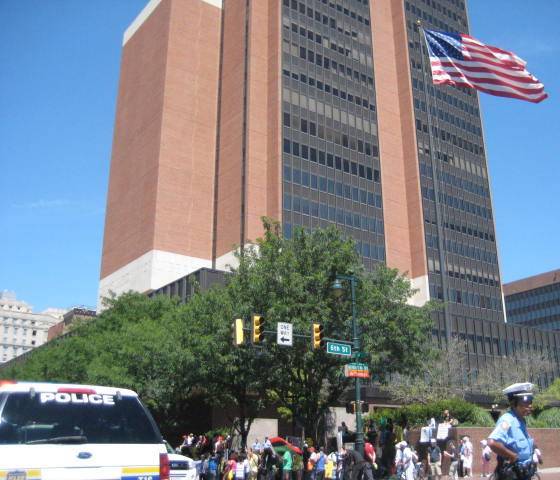 Gather on a street corner with a loud speaker and protest the government. The Police and Old Glory guarantee your liberty. I've spent time in countries where they would haul you in and slap you around for this. Thank you first amendment! |
| I will tell you what WAS on folks minds on July 4th, 1776: Fred Fintsone and Barney Rubble! That's right folks, Flintstones!
"Resolved, That the Board of War be empowered to employ
such a number of persons.... in their
respective states, where the best flint stones are to be
obtained, with samples of the same Resolved, That an application be made to the committee of safety of Pensylvania
for a supply of flints for the troops at New York: and that the colony of
Maryland and Delaware be requested to embody their militia for the flying camp,
with all expedition, and to march them, without delay, to the city of
Philadelphia. Imagine. With all congress had going on they still had time to be concerned about the Flintstones. It just goes to show you that there is plenty of mundane work that goes into running a revolution. By the way, Mr. Henry Wisner referenced above, who would be on the trail of the Flintstones, is from Orange County, NY. He is a home town boy from Goshen, NY in our neck of the woods. That would be a great research paper to look at the guys who were in congress on July 4th, took part in the work that brought us independence, even supported independence and yet missed out on being part of one of the most exclusive clubs in all of human history: the 56 men who are immortalized as The Signers of the Declaration of Independence. Mr. Wisner was apparently not in Congress on August 2nd when the formal signing of The Declaration was done. Dang. |
|
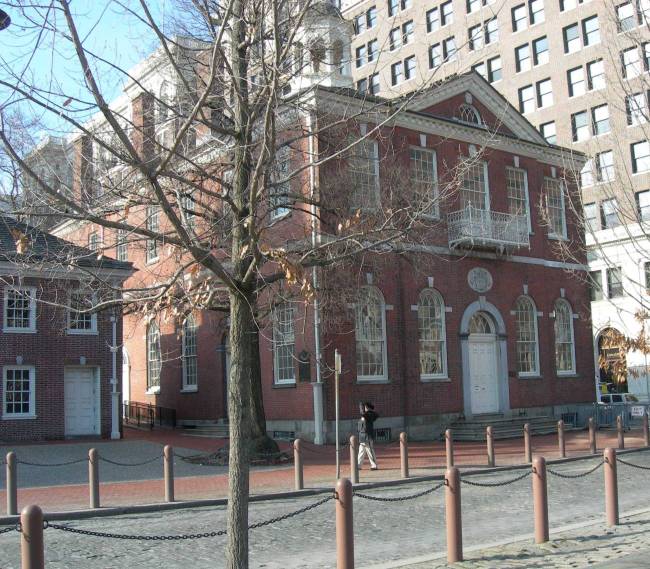 |
Many people visit Independence
Hall and leave without realizing Congress Hall is a separate visit. It is
arguably the fourth most important building in American History behind
Independence Hall, The White House and our current Capitol. It served as
our capitol from 1790-1800 before Congress moved to DC. After the short
stay in NY City, It is where Congress really got going under the new
Federal Constitution. Congress had a country to create. The Constitution
was only the rule book. The Senate chamber is where Washington was sworn in for his second term. You will visit the House where the first transfer of power took place when John Adams was sworn in. It is where Congress began to actually create a government around the frame of the Constitution. Eleven signers of The Declaration served here in Congress as did four future presidents: Madision, Monroe, Jackson and W.H. Harrision. |
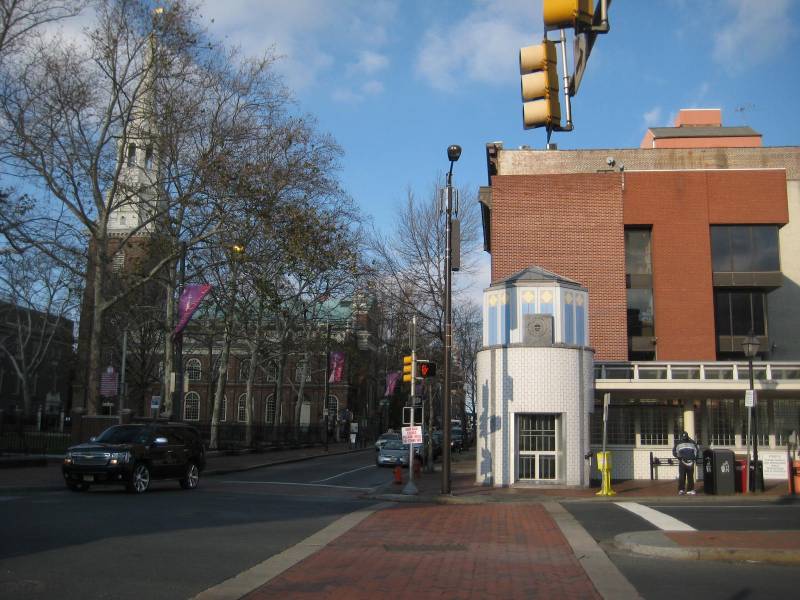 |
That's the Penns Landing
subway station at 2nd and Market street. But that's not all. Allow your
mind to time travel back to 1731. Christ Church you see in the background
was there. So was Benjamin Franklin's first printing shop. It occupied the
corner where you see the subway station. You are
looking across Market St at his print shop. Stand here on the corner and imagine him coming out of his shop and maybe delivering a print job to Christ Church you see there up the street. I'll give you one better. If you were standing on this corner one morning in 1723 you would see 17 year old run away Ben Franklin walking from right to left through this picture. He tells us in his autobiography that he arrived by boat and walked down Market St to 4th St. He had but a few coins in his pocket, was bedraggled, wet, and hungry. More later on the famous "puffy rolls". |
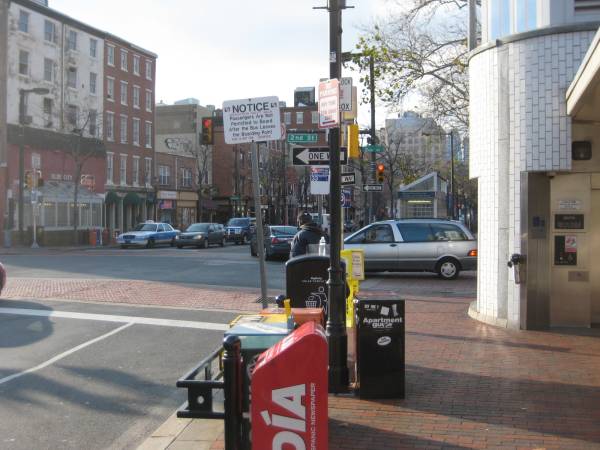 |
Here you are standing at his print shop looking down Market St in the direction he went. |
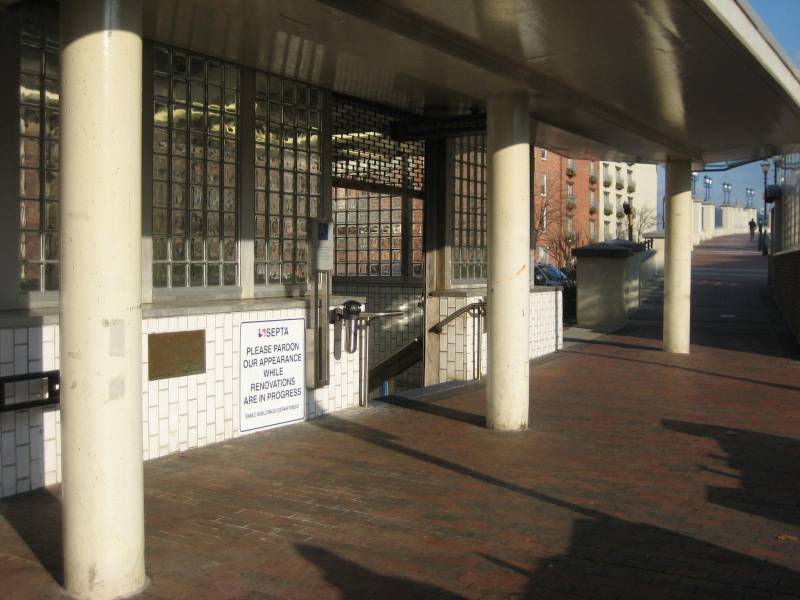 |
 There
you can see the plaque marking the print shop. Click on the thumbnail to
enlarge it. People of Franklin's youth would have still remembered a time
when books and printing presses were licensed by the government. There
you can see the plaque marking the print shop. Click on the thumbnail to
enlarge it. People of Franklin's youth would have still remembered a time
when books and printing presses were licensed by the government.For over 200 years printing had been regulated "to protect the state against nonconforming religious and political opinions.."1 A 1586 law named only three towns in England where printing could take place. Two bishops were to decide the number of presses allowed. All books were licensed. Even more restrictive licensing acts were passed. Casting type required permission from the Stationer's Company, a guild created by royal charter to prevent Protestant writings. It was given a printing monopoly, wide search powers to police the law and burn prohibited books. There were restrictions on imported books. Gradual opposition caused the last licensing act to expire in 1695. Ben Franklin's contributions are legend. His inventions, experiments, business skill, self made wealth, writings, public service, leadership and diplomacy made him world famous in his own time. His contributions to the development and preservation of liberty are at the core of our American experience. After all these professions and accomplishments, at the end of a long life he described himself in his will simply as "Benjamin Franklin, of Philadelphia, printer," 1 Sources of Our Liberties; Edited by Richard Perry, American Bar Foundation 1952. page 242
|
|
In grade school you probably learned the story of how the Liberty Bell cracked. There was a little kid standing outside the Pennsylvania State House, now called Independence Hall, waiting for news that the Declaration of Independence had been adopted. When it was, he called up to his grandfather in the steeple tower and yelled, "Ring grandfather, ring for liberty." Grandpa did and the Liberty Bell cracked! The trouble is, like so much what we get taught about history, it is not true! In fact, visit the Liberty Bell and Independence hall. You will learn that there is strong reason to believe that no one would have dared ring the State House bell (our Liberty Bell) on July 4th or on any other day. The bell tower was in very bad condition. It was slated to be demolished and replaced. Due to its dangerous condition, swinging a 2,000 pound bell would probably have been a bad idea. Also, independence had been declared on JULY 2nd! That's right. The Continental Congress declared its independence from Great Britain on July 2nd, not July 4th. It is unlikely that any city wide bell ringing celebration took place on either of those days. July 8th did see a large celebration when The Declaration was publicly read to a large crowd in the yard of Independence Hall. Never the less, look what I found in the Old Pine Street Presbyterian Church Cemetery
|
|
| Birthplace of the United States Marine Corps |
City Tavern: An authentic historical tavern (reconstruction) but going in there does feel like time travel. Historical menu, wait staff in period dress, and great micro brews using Washington's and Jefferson's brew recipes. This is fine dining but moderately priced for what it is. For the experience it is a good value. 138 South 2nd Street at Walnut St, Philadelphia, PA 19106. About a ten minute walk from Independence Hall. |
